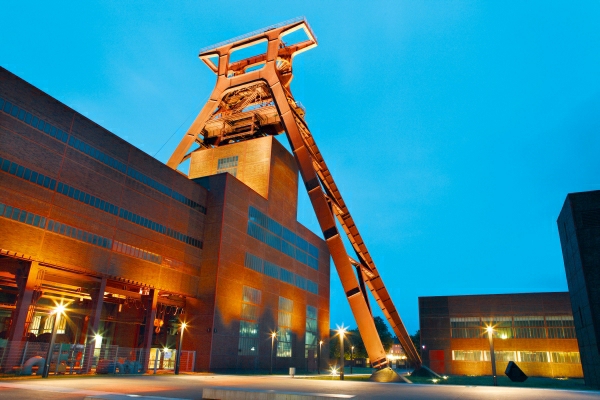Essen, The Ruhr, ECC 2010
Zollverein Complex, Ruhr Valley
Architect: Rem Koolhaas
Text: Eszter Götz
Photos: Essen, ECC 2010
With Essen as one of the cultural capitals of Europe, the cultural programme is spread all over the Ruhr Valley region throughout the year. The ECC programme focusses on a change of profile whilst preserving the industrial heritage of the region. Once a prohibited town, the centre of munitions industry and heavy industry in Germany has grown into a large-scale establishment of tourism and culture, completed with museums, conference and research centres whilst remaining the predominant power of Germany’s creative industry. Contemporary architecture has played a key role in the structural transformation. The central building houses the Ruhr Museum designed by Rem Koolhaas opened in January, 2010. Some 80 per cent of the mining machinery, coal selecting and cleaning equipment is still being treasured here: after being renewed, they have been integrated into the historical exhibition. Films projected onto the walls of machines and the passages leading into the underground galleries help visitors to understand what kind of lifestyle coal-mining in Germany meant for some 150 years. Viewing the landscape from a panoramic terrace we can see the whole Zollverein with Red Dot Museum designed by Sanaa Japanese architects’ office the simple cube of which is not compromised by anything. The 134 windows piercing the facade at random expose and reveal small sections of the industrial region.
Scene Ungarn – Contemporary Hungarian Festival
Text: Eszter Götz
Populated by 18 million people, North Rhine-Westphalia has hosted Scene, a Gesamtkunstwerk festival organized every other year since 1992, focussing on the contemporary culture of a different country each occasion. This year it is Hungary, because of the joint European Cultural Capital programme of Pécs and the Ruhr-Valley region. It is a self-evident choice as the locations can thus mutually attract attention. More than 200 events in fourteen towns and cities present contemporary trends prevailing in Hungarian fine arts, theatre, literature, film, photograhy and media art without classification. German organizers have recognized the potentials and power of a joint action whilst in Pécs this opportunity has been missed: except for a few events the German venue is not represented in Hungary.
The Legend of a Modern Museum: Folkwang Museum, Essen
Architect: David Chipperfield, 2010 (Edmund Körner, 1927; Kreutzberger-Hösterey-Lay, 1960)
Text and photos: Eszter Götz
In 2010 another legend of art history, the Folkwang Museum in Essen was reborn for the fourth time. The name derives from the Edda songs, folkwang there means „the people’s hall”. When in 1898 the founder, Karl Ernst Osthaus first defined the concept of the museum as the hall of people, it was quite similar to the vision was embodied here in January, 2010 waiting for visitors. Echoing the character of the existing structure with delicate shifts, the design by David Chipperfield was the winner of the international tender for extension in 2007. The whole building is defined by natural light and openness. Every space is directly lit, either via the whole-size glass wall, or where it is not possible, via opaque frosted glass skylights. The majority of the collection is not responsive to light: these works shall be displayed in rooms flooded by exterior light, whilst antique pieces and rarities – among them unique Copt textile fragments – are treasured in the more closed inner rooms.
Client: Neubau Museum Folkwang Essen
Design: Architecture LP, David Chipperfield Architects
Architect: David Chipperfield
Electrical engineering: bbt Ingenieure GmbH
Statics: Puhl und Becker
Landscaping: Meinolf Hasse
Light planning: Arup GmbH
Safety conception: ifas Institut für Angewandte Sicherheitstechnik














